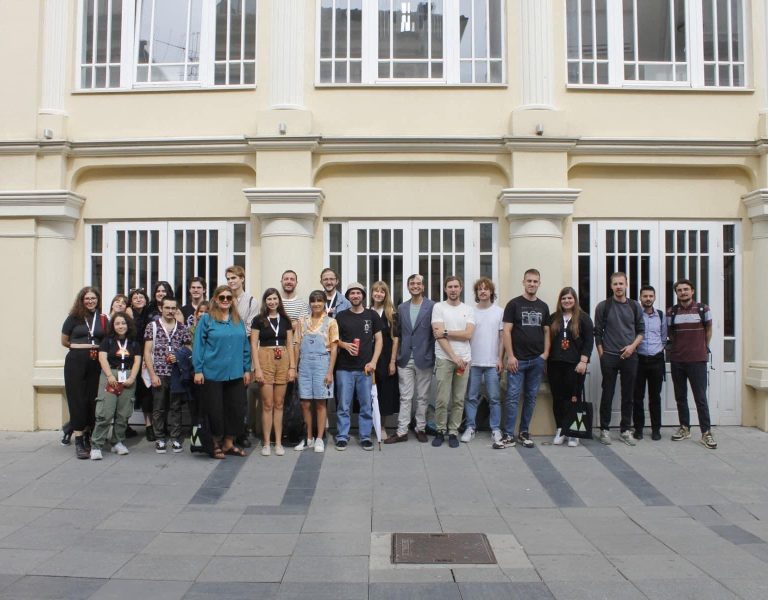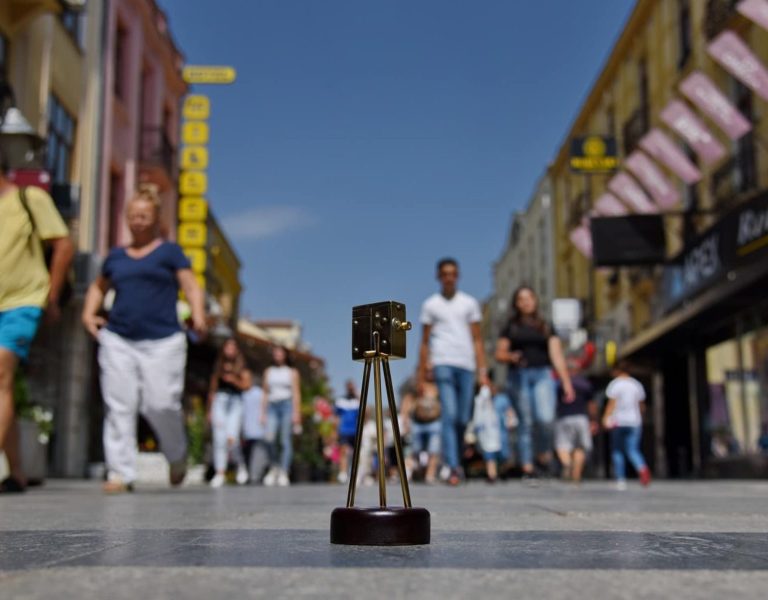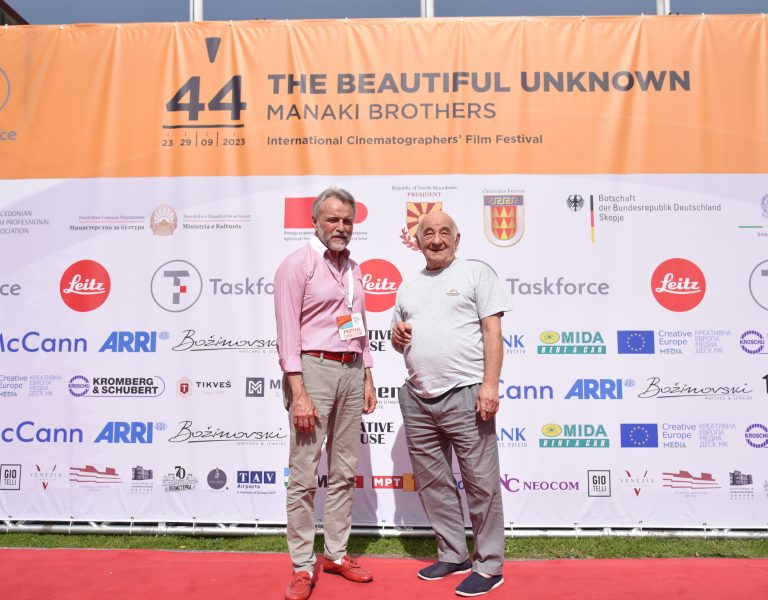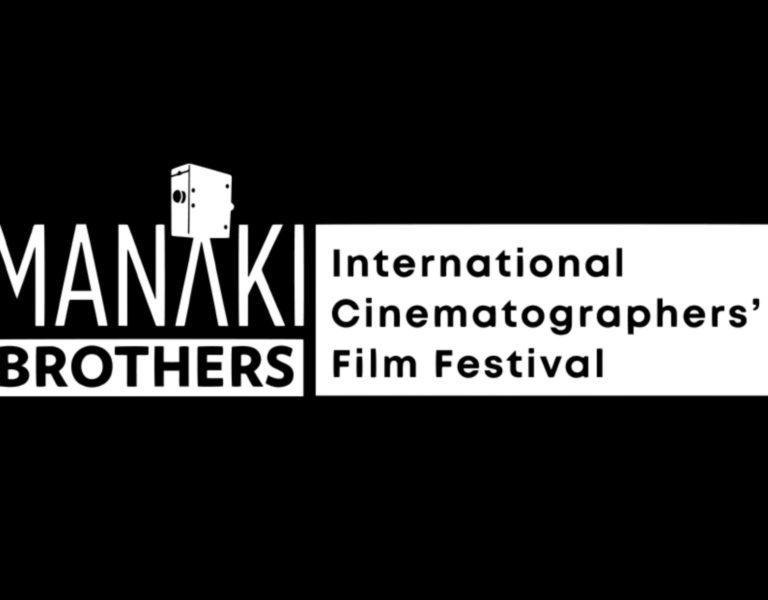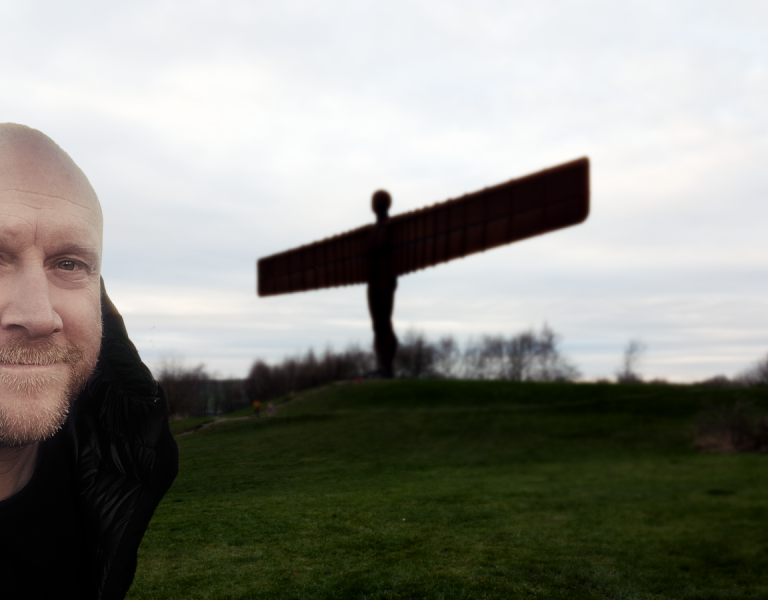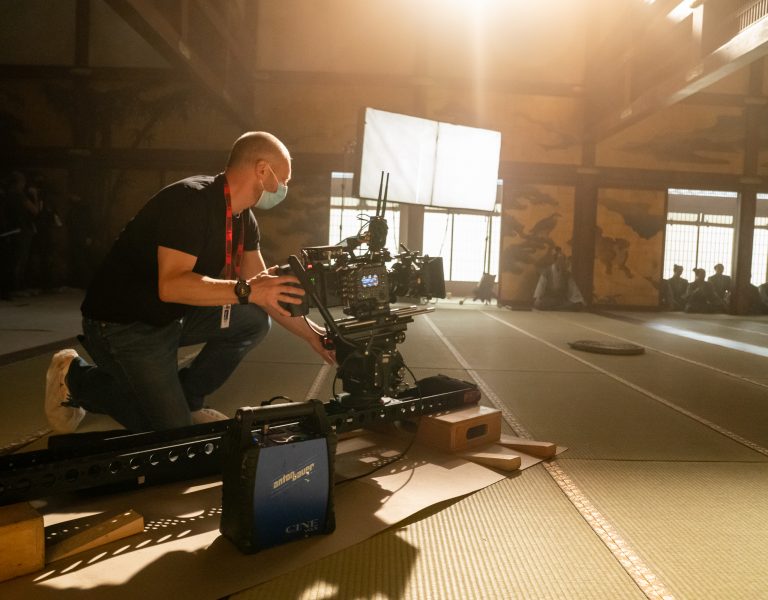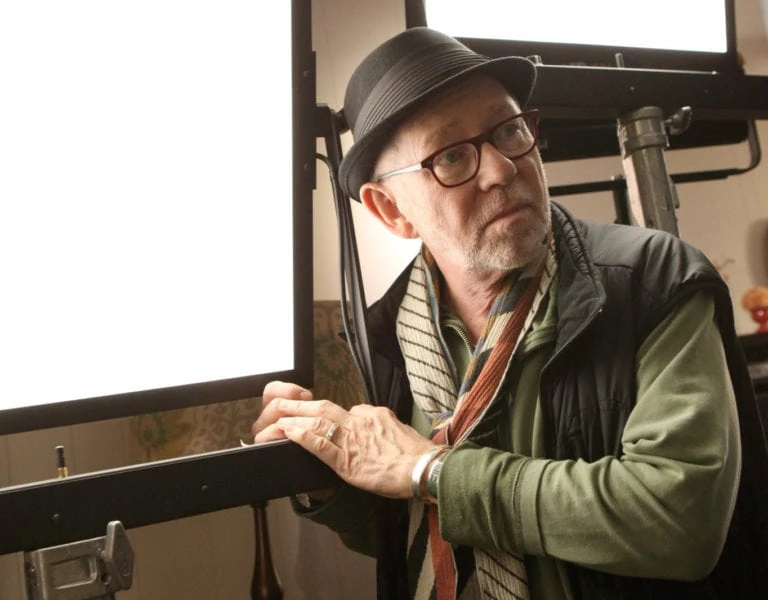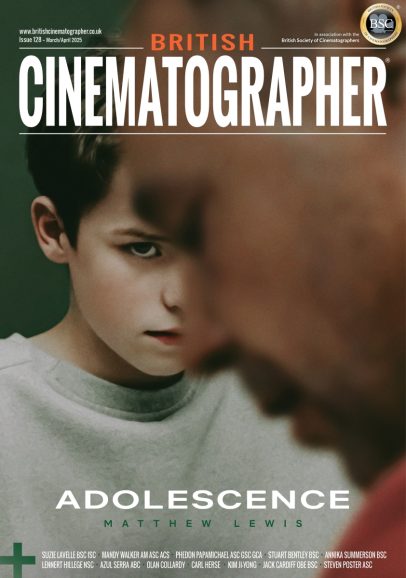THERE IS ONLY ONE MANAKI
Celebrating the craft of cinematography for 45 years, Manaki Brothers Film Festival is renowned for its intimate, educational, and inspiring environment. British Cinematographer joined filmmakers, jury members, and the festival team to immerse ourselves in the magical world of Manaki.
Imagine a place where you walk down streets paved with glistening gold stars adorned with the names of cinematographic masters, pass Peter Biziou BSC and Bruno Delbonnel ASC AFC catching up over coffee, and spot a group of filmmakers – including John Seale AM ASC ACS, Nancy Schreiber ASC, and up-and-coming DPs – outside a cinema discussing the film they’ve just seen.
It might sound like a scene from a cinematographer’s wildest dreams, but for a week every September this magical land exists when the city of Bitola in North Macedonia is transformed into a filmmaker’s haven for Manaki Brothers Film Festival, the oldest film festival dedicated to cinematography.
This year marks the 45th anniversary of the event which was founded by the Macedonian Film Professionals’ Association (MFPA) , the Cinematheque of Macedonia, and host city Bitola, to honour the cinematic work of the Manaki brothers, Yanaki (1878-1954) and Milton (1880-1964). In 1905, Yanaki travelled to London where he bought a Bioscope film camera with which the brothers shot the first film in Southeast Europe, starring their 114-year-old grandmother.
The event has evolved with the industry ever since. In 1991, following the Declaration of Independence of the Republic of Macedonia, it morphed into an international festival of world cinema, celebrating feature films and recognising achievement through the Golden, Silver, and Bronze Camera 300 Awards (inspired by the serial number of 300 on the camera the brothers used back in 1905). Now the festival boasts a packed programme of seminars, networking, screenings of and awards for feature, student, short film and European lo-cap productions, and spectacular opening and closing ceremonies attracting filmmakers from around the globe.
Creative connections
Despite having developed, part of the festival’s charm is the intimate and personal environment which remains. This year’s strapline for the event – ‘There is only one Manaki’ – perfectly encapsulates the festival’s unique and supportive atmosphere, offering filmmakers at the start of their careers priceless access words of wisdom from Oscar-winning DPs. This friendly and welcoming atmosphere stood out to many we spoke to, both those who return year after year and first time attendees such as DP Karolina Pajak FSF who found “the small size of the festival made it easy to connect with other cinematographers”.
Two of the many talented cinematographers who agree Manaki presents an opportunity for cinematographers, societies, and associations from all around the globe to unite are IMAGO (International Federation of Cinematographers) president and former ABC president, Mustapha Barat ABC, and SBC vice-president and IMAGO co-vice president, Bojana Andrić SAS. Barat’s first experience of the festival this year exceeded his expectations, giving him the “opportunity to meet great cinematographers from all over the world and exchange ideas and knowledge. There aren’t many events like Manaki in the world – a festival about cinematography and cinematographers – so it’s very inspiring.”
Andrić, who grew up in the same region, in Serbia, added, “Manaki was always my dream when I was studying as everyone talked about how important it is. I’m happy to finally come here as a cinematographer and to see all the value it offers.”
As much as the film-related fun and insight is a draw for many, some are also charmed by Bitola’s community of stray dogs which wander the city and even gate-crashed some of our interviews and the red carpet opening and closing events.
At the glittering opening ceremony, held in the Bitola Cultural Center where many of the screenings also take place, the Golden Camera 300 Lifetime Achievement Award was presented to Bruno Delbonnel ASC AFC, while the Golden Camera 300 for special contribution to the world of film art went to Polish cinematographer Jolanta Dilevska, and the Star of Macedonian Film was presented by the Society of Film Workers of Macedonia to Macedonian editor, Dimitar Grbevski. After the ceremony, Paolo Sorrentino’s Parthenope – lensed by Dario D’Argentino and competing in the Main Competition – was screened.
Film screenings, many followed by Q&As with the cinematographers – are among the programme’s strengths, giving access into the creative minds of directors of photography such as Michał Dymek who shot stunning yet harrowing black-and-white film The Girl With the Needle or the techniques used by Pablo Lozano when lensing supernatural comedy-drama Chronicles of a Wandering Saint.
Festival attendees also enjoyed a visual treat in the form of the I of the Lens exhibition, curated by Vika Safrigina and Susanna Kraus in partnership with IMAGO’s international Federation of Cinematographers Diversity and Inclusion Committee, Sumolight, and Leitz Cine. The exhibition aims to celebrate diversity of filmmakers in this special industry through life-sized portrait photographs of distinguished cinematographers from across the globe, created using the world’s only analogue large-format camera – the IMAGO Camera
In addition to the activities and screenings, British Cinematographer joined filmmakers, jury members, event partners, and festival director Simeon Damevski on a trip to beautiful Lake Ohrid, presenting a chance to connect with cinematographers, camera operators, gaffers, DITs, and other filmmakers about their work and highlights from the festival.
In the picturesque waterside setting, Peter Biziou BSC (The Truman Show, Mississippi Burning) shared knowledge and stories from a phenomenal career during which he enjoyed every movie he worked on. “If the script turns me on the first thing I do is speak to the director to see if we are on the same page. I loved working with Terry Gilliam on Time Bandits, for example, as he’s so inventive and creative”. Biziou advised young budding creatives with ambitions to work in the film industry to “just be very keen and know that you want to be in that world”.
Biziou – who praises the festival for “recognising cinematographers as authors” – is among the previous Golden Camera 300 Lifetime Achievement Award winners deserving of the shining star inscribed with his name which was unveiled this year, marking the festival’s 45th anniversary. Crowds gathered on the walk of fame as Damevski revealed stars of previous winners who were at this year’s special event including Dante Spinotti ASC AIC, this year’s winner Delbonnel, and John Seale AM ASC ACS. Other winners’ stars shining bright include Sir Roger Deakins CBE ASC BSC, Chris Menges BSC, Anthony Dod Mantle ASC BSC DFF, Ed Lachman ASC, Billy Williams OBE BSC, and of course the Manaki brothers.
Knowledge is power
After receiving the lifetime achievement award and delivering a masterclass to a packed theatre exploring his standout productions including Inside Llewelyn Davis, Darkest Hour, Faust, and Amelie, Delbonnel spoke with us about the significance of receiving the award. “First of all I turned it down as I said I’m not old enough and not in that league, but when I saw the names of others who had received the award I wanted to pay respect to those amazing cinematographers I admire, influenced me, and whose movies I watched and learnt from,” he said. “So it is also a way of saying thank you to those incredible cinematographers.”
He also acknowledges that 2001’s Amelie – a movie he joked he has “spoken about enough” – changed his life. “Suddenly I got projects from very established directors such as the Coen brothers, Aleksandr Sokurov, and Tim Burton, each one having a very different approach to movie making and very different stories which is the beauty of cinema.”
Other standing room only sessions included a panel with cinematographic masters John Seale AM ASC ACS, Dante Spinotti ASC AIC, and Christian Berger AAC BVK, sharing fascinating and entertaining anecdotes from shooting an extensive list of remarkable productions. After the session, head of the feature film jury, Seale, praised the festival’s “warm, welcoming atmosphere and lectures which instigate a great enthusiasm in filmmakers” and shared details of what inspired him to enter the industry with us. Initially wanting to be a National Geographic cameraman he worked at ABC TV in Sydney for seven years, before he “found drama and realised that using the camera in that way to capture actors and scenery was incredibly exciting”.
Elsewhere in the educational programme, Nancy Schreiber ASC, Mustapha Barat ABC, and Brazilian cinematographer Lula Carvalho ASC ABC discussed lensing techniques and filmmaking approaches during a Leitz-hosted session, DIT Krzysztof Włodarczyk explored how The Zone of Interest was shot with 10 Sony Venice cameras in confined spaces and working with natural light in a technical session, and Slovenian cinematographer Mitja Ličen took part in a session from ARRI exploring the film he lensed, Family Therapy, which competed in the festival’s Lo-cap competition. Attendees also enjoyed a masterclass with Polish cinematographer Jolanta Dylewska, from her studies at the Polish Film School through to shooting productions such as In Darkness, a tale of Jews hiding from the Nazis in the sewers under Lviv during World War II.
The Powerful Women of Manaki panel was one of many examples of the festival’s focus on not only striving for a diverse event but equality in the industry. Featuring an all-star line-up of Nancy Schreiber ASC; Alice Brooks ASC; Teresa Medina AEC; Oona Menges BSC; Claire Pijman NSC; Agnieszka Szeliga ACO; and Birgit Guðjónsdóttir, hosted by Christina Nowak, it was an inspiring, enlightening and honest discussion highlighting experiences and sharing advice for female filmmakers.
Schreiber was also the worthy recipient of the inaugural Trailblazer Award, honouring craftspeople who are pioneers in their profession, acknowledging how she helped pave the way for and inspire other female cinematographers. Speaking with us about the festival, which she considers a “gem” of an event for cinematographers, after attending a screening of Living the Light – a documentary about one of her inspirations, the late great Robby Müller NSC BVK – Schreiber expressed her support for the diverse festival programme featuring many cinematographers she admires.
“I’m honoured to be at this important festival, meeting people from all over the world – cinematographers and those who support us,” she said. “And I’m thrilled to receive the Trailblazer Award from my peers, to be part of the Powerful Women of Manaki panel, and that there are so many female cinematographers at the festival. We know of each other through the various organisations we’ve formed to promote our voices because we can often be overlooked. The numbers are still not great – 12% of shows were shot by women in Europe and 7% in the US – so we have a long way to go, but bringing us all together and our voices being heard is important.”
Mentoring also came under the spotlight during a panel discussion between Fabian Wagner ASC BSC, Szeliga, Brooks and Medina. As well as talking about their own experiences of mentoring, Wagner and Szeliga shared details of the First Steps Cinematography initiative they established to allow young and diverse filmmakers to start their journey in film and television.
Education and nurturing the next generation of filmmaking talent remains a focus for the Manaki team all year round. “This is a place that nourishes cinematographers from their very beginnings, from their student films through to high-level feature films,” festival director Damevski told us. “Outside of the festival we also organise a Descendants of Manaki workshop teaching students about the Manaki Brothers, language of cinematography, and editing. Along with a documentary festival, we also take travelling movie theatres to rural areas of Macedonia to screen films to young people.”
Shining stars
During the closing ceremony, gaffer David Smith and Alice Brooks ASC, who recently collaborated on Wicked, received the Creative Synergy Award – a new addition to the festival. Speaking to us ahead of the glittering event, Smith highlighted the award’s significance in “showing recognition for people who don’t normally receive it.” Brooks added: “Filmmaking takes an army of people and there are so many crafts that aren’t recognised. David and I were so lucky to work together on Wicked and I’m grateful this award is being presented as the gaffer-cinematographer relationship is so important.”
Winning films from the festival’s competition strands were also revealed during the closing event, followed by a screening of Macedonian movie Kill the Children First by Dimitar Orovcanec (Cin. Vladimir Samoilovski). The jury – comprising cinematographers jury president Seale, Birgit Guðjónsdóttir, Agnès Godard, Cevahir Shahin, and Macedonian director and screenwriter Vladimir Blazevski – awarded the Golden Camera 300 to cinematographer Judith Kaufmann BVK for The Teacher’s Lounge, Silver Camera 300 to Ranabir Das for Everything We Imagine as Light, Bronze Camera 300 to Rasmus Videbæk for Promised Land, and special recognition in the main selection to Pablo Lozano for Chronicles of a Wandering Saint.
In the short film competition, jury president Schreiber, Oona Menges BSC, and Gjorgji Klincarov awarded the main prize to Hélcio Alemão Nagamine for Amarela, with special recognition given to Kinan Massarani for Good Boy. They awarded Margot Besson the grand student prize for Anansi. The top prize for documentary film – decided by Kurshat Uresin, Yani-Peteri Passi, and Núria Roldos – went to Hatem Necchi for The Mother of All Lies and the award in the European Lo-cap film category was presented to Vytautas Katkus for Toxic.
Icelandic-Austrian cinematographer Birgit Guðjónsdóttir spoke to us about her experience on the feature film jury and the magic of Manaki – a festival she describes as “like being in a cinematography family” where she can discuss cinematographers’ work with fellow filmmakers she considers heroes. “When judging we were always looking at what is special, what is different, and how is cinematography telling the story and adding something it. It’s a very interesting process and I love talking with other cinematographers about our work, so I’m learning a lot too.”
Damevski – who has been event director for the past four years – has seen the festival grow from an understandably lower attendance of 100 people pandemic during the pandemic year, to 230 the following year, jumping to 467 last year. Looking ahead to the festival’s future, Damevski and the team have big ambitions to continue to evolve the programme while preserving the intimate and personal atmosphere it’s renowned for.
“I’ve discovered cinematographers like the intimate environment and want to meet with their colleagues to discuss the craft, so this is the perfect comfortable space for that,” he says. “Cinematographers have told me they want to keep the intimacy but I also understand the necessity for the industry to be part of it, so we make it very informal and don’t have exhibitor booths or equipment. Instead there are workshops and masterclasses and the limelight is on the masters of their craft which is how it will remain.”
